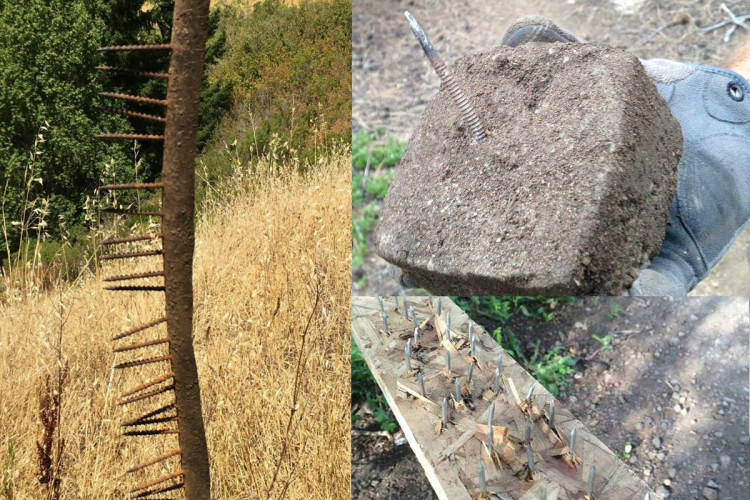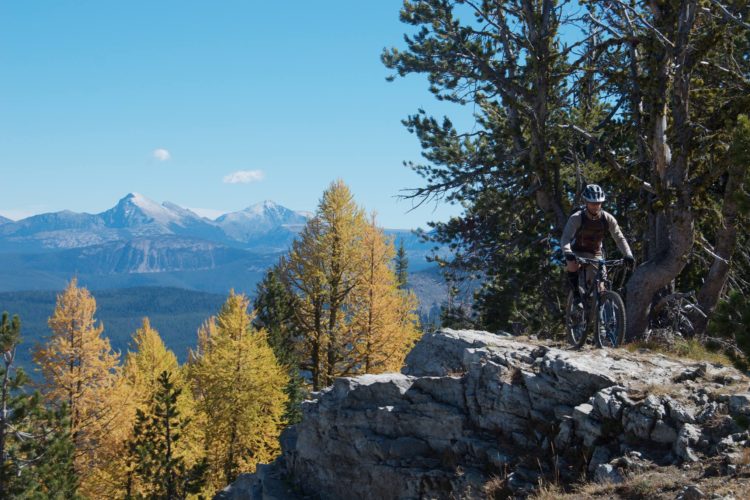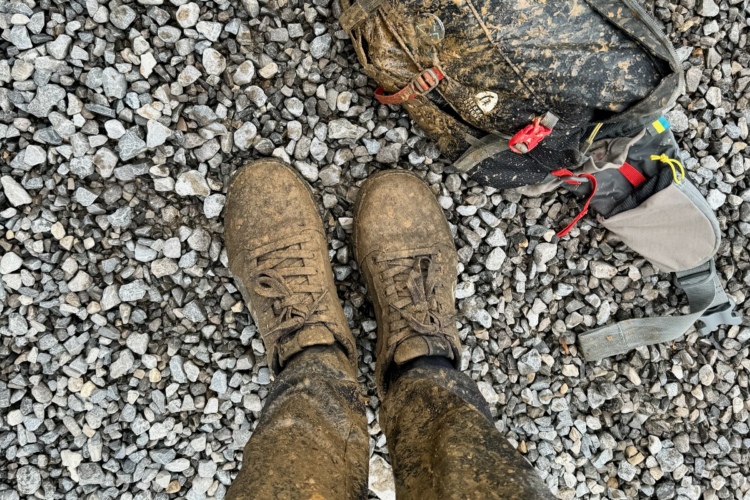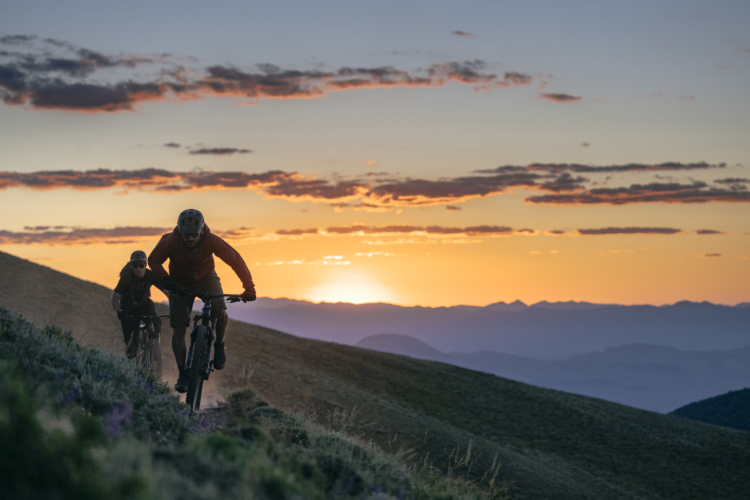More and more, I find myself having trail déjà vu—the feeling that I’ve ridden this trail before—even when I haven’t. With over 350 trails under my knobbies, you might think it’d be easy to forget that I had ridden a particular trail before, but that’s not it. My mind naturally remembers, catalogs, and categorizes by a variety of factors every trail I’ve ridden. Forgetting I’ve ridden a particular trail just simply isn’t going to happen.
With that many trails behind me, it’d also be easy to think I’ve ridden every type of trail there is, so no matter what new trail I ride, it will at least seem like some other trail I’ve ridden. While there’s some merit in that thought, what I’m noticing here is something more… something based in a real trend and not just in my mind… something I call trail homogenization.
While I grew up drinking homogenized milk, and that’s okay, I’m not so keen on riding homogenized trails. There are a number of reasons for this genericizing of mountain bike trails, which have root causes ranging from historical to political to environmental to technological. While there’s a solid foundation under each of these root causes, the end results aren’t always appealing.

Historically, most of the trails we’ve ridden were far from homogenized because they weren’t designed with mountain bikes in mind. Mountain biking as we know it didn’t exist before the 1980s and didn’t gain widespread popularity until the 1990s. Consequently, the trails we rode were the original domain of hikers, motorcyclists, equestrians, or cross-country skiers. Trail design for each user group was pretty broad, so combining the full inventory of available trails yielded incredible variety for the mountain cyclist. While the trails my not have been originally designed and built for mountain bikes, mountain bikes were designed and built to be able to handle these trails. As mountain biking has grown, so have our skills as bikers; combine that with the improvements in technology, and there’s very little which can’t be ridden.
Now that mountain biking has a large, and growing, following, some new trails are being designed specifically for mountain biking. This usually means a certain grade, curves of a certain shape, often including berms, and routing over certain obstacles, but around other obstacles. Many of these new trails end up being very similar to each other. This doesn’t just pertain to new trails; as older trails require reroutes, the replacement sections often take on this “standard” character. Add to all this the continuing re-designation of currently bike-legal trails as hiker and/or equestrian only trails, and we lose a lot of that originality.
While it can be great fun to hit a purpose-built mountain bike trail specially designed to maximize and maintain flow, there’s a special satisfaction that comes with cleaning that craggy old bike-hostile trail with the inconvenient root garden and the super-tight, v-shaped switchbacks with rock drops right at the crux of the turns. I believe eliminating the latter and replacing it with the former chips away at an important part of the soul of our sport.

Politically, we face the loss of trail access as noted above, and, as we try to develop new trails, having multi-user support is often essential to the approval and funding of new trail projects as well as the maintenance of existing routes. Think of that exceptionally cool rock roller you want to route your next trail over: it’s death to an equestrian. If you want to be able to cut a new trail on public land, in most places, it helps to have the support of those equestrians, so the trail needs to be horse-friendly as well. Similarly, some features appealing to cyclist will be unappealing to hikers as well. Where we once had trails constructed with a particular user in mind, we now often try to design trails that will offend none, and in the end this is another uniqueness killer.
Beyond the history and the politics, our greatest difficulty in bounding what we can do with a trail may lie in the environment itself. Trails must be sustainable, more so today than ever. With population growth placing ever increasing demands on trails, only a well-designed trail will be able to survive the usage it receives. Furthermore, with budgets for trail maintenance being cut, trails must be able to stand on their own with minimal assistance.

There are many elements of sustainable trail design which drive a similarity between trails designed to those parameters. Sometimes it’s fun to just point your knobbies straight downhill and let ‘er rip… but not on a sustainable trail! Straight fall-line trails are the perfect path to erosion and unsustainability, so trails on hilly terrain must be side cut. Even then, the grade cannot exceed a certain percentage, especially over a long distance. Each steep section must be cut short and followed by a level or slight uphill section to prevent too high a volume of water from gaining too much force, which can again drive erosion and unsustainability.
Many bikers tend to charge hard and then hit the brakes at the last second when faced with a sharp turn or switchback. Skidding is yet another erosion creator. Consequently, modern trail design dictates a gradual slowing of speed to prevent the need to skid, again driving a similarity in final trail shape.

Cutting new trail is hard work. It requires a great deal of labor, which means either an army of volunteers or a big checkbook to turn over to a commercial trail building agency. We now have access to machines which cut new trail at many times the rate of human beings with Pulaskis and McLeods. These technological marvels also create a uniformly homogenized trail.

I have reached the point where I don’t go into a new trail with the expectation of having a unique experience. Many trails tout that they are “IMBA designed” with great fanfare, yet I now approach these trails with some trepidation. There’s nothing worse than expending the time and money to take a mountain biking trip only to find the trails you’re visiting look a lot like the trails at home. Yet I have hope that this trend can be halted, or at least mitigated. There are a few things which must be done to prevent mountain biking from becoming stagnant and predictable:
1. Get involved in any public process where you can add your voice to those calling for continued access to those trails where bikers have historically ridden. Continued access to those original, unique trails is absolutely essential to the preservation of the essence of our sport.
2. When building new trails or rerouting existing trails, take every opportunity to incorporate the unique features of that particular topography into the trail experience. While jumps and berms can be fun, they are not fun for hikers or equestrians, and they are an increasingly artificial modification of the landscape rather than a harmonious existence with it. You can build jumps and wooden walls anywhere, but that rock on the side of the mountain? It is unique unto itself, and making it part of your ride will make the ride unique.
3. Break the rules of sustainable trail design when it can be done without undue reduction in sustainability. Anyone who’s ridden Zippity Doo Dah in Fruita knows there are long pitches on that trail which are far in excess of what would normally be a sustainable grade. However, the way that soil compacts, combined with the low moisture the area receives, makes these pitches prime for ripping fall line runs.
4. Get out there and build trail yourself… by hand, when possible. Make it narrow, give it contours, and most importantly, give it character.
Bottom line: as trail consumers, we need to be clear to the powers that be, whether they be private interests or state, local, or national authorities, what type of trail experience we want. If, in the aggregate, we want a Wal-Mart or McDonalds equivalent experience, so be it. But I’m willing to wager most of us would rather have a local, mom-and-pop shop-style mountain bike trail experience, with each trail providing its own entertaining, unique vibe.
Your Turn: We want to hear your thoughts on trail homogenization. Sound off in the comments section below!











33 Comments
Dec 4, 2013
Although gnarly riding is not my forte I fully agree with you. I hate the one size fits all philosophy for anything. When I go ride a gnarly trail with friends and curse and crash my way through it I think it is crappy that as the sport grows these trails seem to be more neglected in being built and maintained.
Nov 6, 2014
Dec 3, 2013
Trails CAN be sustainable AND unique and entertaining!
Dec 3, 2013
I saw your strava post from that ride. Even though I've spent a good deal of time in Canon City, I've never ridden that area. Have actually avoided it knowing that it's mostly doubletrack and dirt roads . . . until now. It sounds like a good deal of new singletrack has appeared with more to come, so I'll be scoping it out before too long.
Dec 3, 2013
Oct 24, 2014
Dec 3, 2013
Dec 3, 2013
A lot of it depends on the machine operator, and the amount of time and care they want to put into it.
Dec 3, 2013
Dec 3, 2013
Dec 5, 2013
I've yet to ride a machine built trail that impressed me, and will definitely be directing my advocacy contributions to projects done by hand.
Dec 3, 2013
Dec 3, 2013
Dec 3, 2013
Dec 5, 2013
I have seen the plans for future trails (and even some of the newest ones built this year) and they are full of character and unique. The total 60 mile plan includes every type of trail so if this is to be true they will totally re-define the specific MTB built trail. Then epic ride centers like CWM is sure to become will have Mcd's and specialized gourmet trails all in one place. Than the newbie will flow with the air in his hair and get hocked fast (instead of trying Cheaha and giving up on MTB because it is hard had no fun at first). Then while on the flow stuff see the expert stuff and always have a challenge to look forward to as he advances. If he never desires to advance he always has the flow.
Dec 3, 2013
That's not to say this is good or bad--there are pros and cons as you mentioned. McDonalds is a lifesaver when you're somewhere unfamiliar and don't know where to grab a quick bite but it's never an exciting choice. I ride mountain bikes for a lot of reasons and sometimes that means trading off flow for surprise or the other way around.
Dec 3, 2013
Dec 3, 2013
Dec 4, 2013
Dec 4, 2013
Yeah, I know, we should build user specific trails. That would be ideal, but around here at least, there is just too much demand for all trails for us to have the luxury of building many trails for specific groups. It is happening, but there is so much work to do to satisfy the general user that it is hard to shunt resources toward bike specific trails.
Sustainability is another factor. We spend so, so, so much time fixing up trails that weren't built to be sustainable that it is hard to get out there and (re)build trails that are sustainable and fun. So much labor gets burned up around here putting proper drainage in the existing trails or repairing areas that are breaking down under heavy usage that there is little effort focused on making a trail a fun and unique experience for bikers. Because of the endless work required to keep the existing trails from completely washing away land managers are really shy about creating any more trail that isn't totally sustainable (i.e., requires little or no maintenance), which means that anything with gnar is going to be frowned upon.
Even when we do get the opportunity to build some new trail we have to deal with all kinds of issues that can turn trails to pure vanilla. Start with the designer, who may or may not understand what makes a fun trail, or who may be under pressure to make sure that the trail appeals to the lowest common denominator and that the end product will need little maintenance. For hand-built trails, which are almost surely going to be built by volunteers, you have the crew leaders, who very often don't understand what they need to stay on top of to create a fun trail, and often don't have a clue what they are doing anyway. Finally, you have the volunteer worker-bees who more often than not have never swung a pick-mattock much less even seen a McCleod before. All of these factors play into creating a trail that just plain isn't all that interesting. In other words, unless you have a deep pool of trail building expertise, you really can't expect that much.
The only way that I can see for trails to be truly unique and interesting is for local bikers to step up and get involved. The more bikers that understand all of the factors that are needed to create a fun trail the more likely that one will actually get built.
On a project I was working last summer I designed in switchbacks that were biker friendly. I couldn't be there the day they built a couple of those switchbacks and guess what, the nice rounded turns that were flagged got built as sharp, v-shaped turns. When I asked why I was told "It was going to take so much work to build them, and no bikers showed up to help, so we said 'screw it' and built them for hikers." If bikers want trails that appeal to them then they need to show up and help instead of waiting for a new trail to get built and then griping about how the trails isn't fun for bikes.
Dec 4, 2013
Excellent, comprehensive, well thought out response--thanks for contributing so much to the discussion!
Since moving back to the Springs, I have done some trail work, mostly on Stephanie's and Palmer Park. Work travel kept me from pitching in on Spring Creek, but I must say that's a very nice addition to the area. I also participated in every one of the planning meetings for the Red Rock/White Acres area.
One thing I find interesting in your post is the hiker complaints about the section 16 reroute. I was an avid hiker for over two decades before getting my first bike. In all that time, I never encountered a trail I thought was bad for hiking. Dips, rollers, rock gardens--they're all part of the hike (at least to me) just as they became part of the ride. In my experience, incorporating the uniqueness of the local terrain works well for either activity. I always thought hikers were akin to "rugged outdoorsmen." It sounds like many of them want an immaculately groomed experience in the backcountry as well?
I'd be curious to know what the project in your last paragraph was . . . of course, if you tell me, I run the risk of feeling bad for not having shown up!
Thanks again for the great post.
Dec 4, 2013
It's interesting that you had so little turnout on 7 Bridges--that's got to be the most popular hiking trail in the entire Pikes Peak region, especially after the loss of Waldo. Of course, it's not a major route for cyclists (either a hike-a-bike up or a huge loop to get to the top side).
Dec 4, 2013
Doing trail design has reinforced the concept "you can't please everybody" in my mind. I am constantly wrestling with trade-offs in what I think different users will enjoy, what volunteers are capable of building, and what can be done with the available amount of labor.
Volunteers are tugged in so many different directions around here that you really have to mount a big marketing campaign to have any hope of having non-trivial turnout for a project. On the Ice Cave Creek project I think we ended up with about 150 man days of effort, which was better turnout than I was expecting -- I didn't think we would finish that segment in one season but we actually got it done, and only with a little bit of corner-cutting. I also work with Friends of the Peak, and I had a work day in North Cheyenne Canon (7 Bridges) last summer where we had only three people show up. It's tough to get things done when you don't have hands to do the work.
Dec 4, 2013
I have talked to people that think I am nuts for putting lots of money into my 26" wheel Kona Hardtail and I have put in lots of money! I ride the 26" wheels for specific reasons (not because I am stubborn I agree with all advantages of 29ers). One reason I love the 26" is for the challenge of hopping over things and working a bit harder. I like to feel the roots and rocks. I don't want the easiest line to just plow over things. I ride to have fun. I race to have fun. I don't necessarily ride for speed which is why I ride a very untraditional XC bike. I know I am not going to win but I know I am going to have fun. Thats the point of it (unless you make it your living racing).
Maybe this is not the place for this topic but do any of you trail/AM riders feel that the technology of modern mountain bike is taking any fun or challenge out of it? I personally don't care what anyone else rides the whole point is to have fun. What works for me may not work for someone else. It seems to me based on the posts above the generic trails being cut out are bumming people out a bit. The bikes being sold are making the generic trails easier. 26" Hardtail anyone? What do you guys/gals think?
Dec 6, 2013
A rigid singlespeed on a beginner trail can be just as fun as a geared fully on an advanced trail.
Dec 4, 2013
I have a nice fully AM bike, but I still break out the ol' 26" hardtail from time to time, just to keep myself technically sharp. I also like the challenge from time to time.
There's an interesting phenomenon at work here which would have sat well in my article. As the sport matures and grows, we as a group, become more capable. Now, add to that, the advances in technology you speak of (suspension, wheel size, light weight, etc), and the demand for gnar will continue to grow.
It's like what happened in the ski industry--with the advent of wider, more stable, shaped skis, more difficult lines became available to more and more people. Where resorts used to focus on their immaculate grooming and user-friendly slopes, many now focus on how much black diamond and double diamond terrain they have.
Now, unlike skiers, we bikers have a problem with regard to this phenomenon, and that is the need for multi-use in most projects. Other user groups don't want all that gnar. So, what ends up happening, is we can only get that gnar (on new projects) in specific, purpose-built bike trails like we usually find in bike parks or lift-served downhill runs. On what may be a purely personal note, I find this to be a real shame since I don't care much for man made stunts, but truly love the stunts which are a part of the natural landscape. That's why I love so many of the old school trails which were built, somewhat ironically, with no thought about mountain biking. As much as we need to be engaged in the development and building of new trails, we need to really dig in our heels on the preservation of some of these older lines as well.
Oct 27, 2014
Hitting a well placed berm or jump just right is more fun than riding the brakes down a fall line, or burning all your energy to get over some water bars up a poorly designed climb.
The gnarly, technical stuff is not going anywhere, the good trail systems have it in their black trails.
Dec 3, 2013
Dec 3, 2013
http://foolsprogress.blogspot.com/2013/01/the-following-is-essay-i-referenced-in.html
Dec 5, 2013
Dec 5, 2013
Oct 11, 2019
Another is simple mechanics: iron-shod hooves scraping down steep dirt will dig away a steep flow section very quickly......just not compatible. Hikers will simply not follow the kind of switchbacks needed to make steep slopes bikeable......they just shortcut. If we don't develop the political clout to push specialized usergroup trails, NO user group will be happy and our Outdoors will become a mess.
If bikers don't show up to volunteer their labor, and we still want trails, we will have to tax them.......like dirt motorbikes. That way we can pay pro builders--- and some bikers don't get an unfair free ride.
Yet another framework is just style: flow shredding with pump and jump is simply a different sport to rock and roll. Even uses different bikes. Let's have both!
Let's get real with our trail design and advocacy. Our political reps should represent ALL aspects of our manic obsession........NOT just become identified with a politically correct middle ground of mediocrity and uniformity.
May 17, 2018
The sad thing is that I moved here in order to access what was once a very outstanding trail system fully accessible year round right in town. Well, it's no long outstanding, but is, as I said, being turned into a toothlessly bland array of boring trails with less and less in way of technically challenging features with the passage of each year.
I am wondering if anyone else is seeing this happen? I am in upstate Washington if you can believe it.